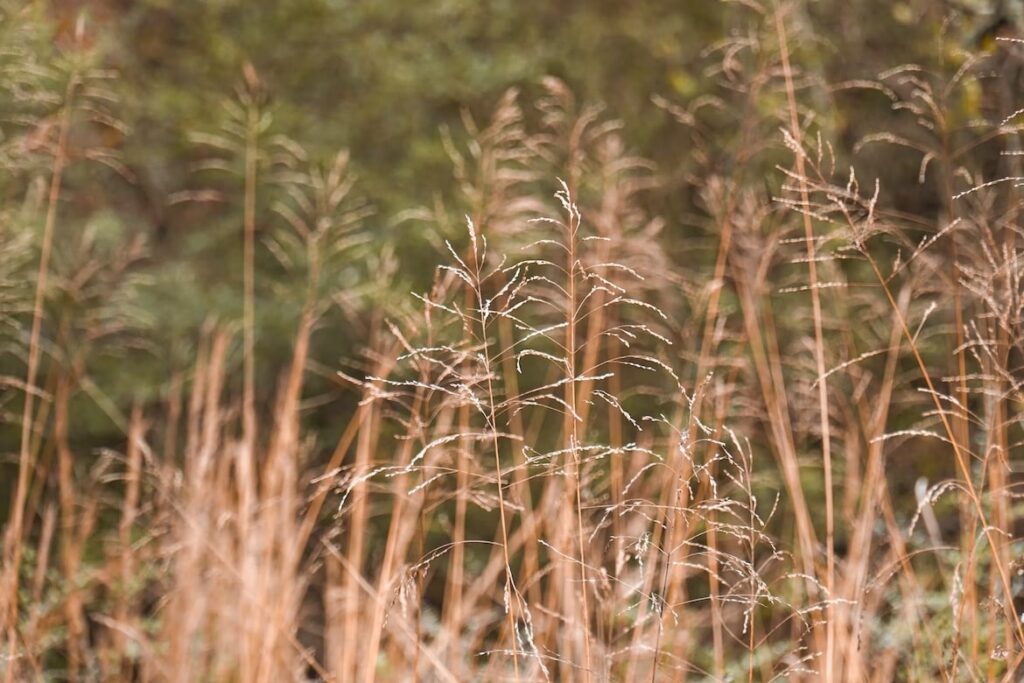
Bothered by the giant weeds in your garden and itching to know what to do with them? We’re here to help.
There are about 12 common types of giant weeds with thick stalks. The most commonly sighted ones are: paulownia tree, pokeweed, sunflower, and rhododendron.
We’ve jotted down important pieces of information, from how to properly identify them and how to effectively manage them.
Identifying Tall Weeds with Thick Stalks
1. Paulownia Tree
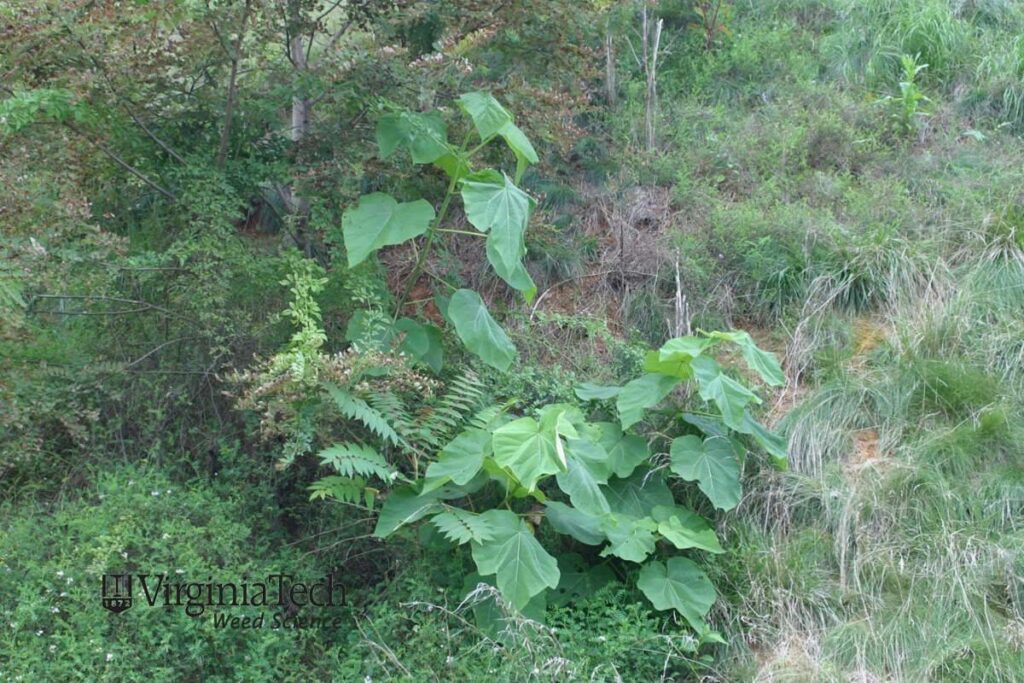
Image: Virginia Tech
| Scientific Name | Paulownia tomentosa |
| Common Name(s) | Paulownia tomentosaFoxglove treePrincess treeEmpress tree |
| Family | Paulowniaceae |
| Nativity | Central and Western ChinaKorean Peninsula |
| Toxicity (Touch) | No |
| Toxicity (Ingestion) | No |
| Unique Characteristics | Thick green stalksLarge green leavesBlue-yellow, lavender, or pink colored flowers |
While technically not a weed, the paulownia tree is widely considered one in several countries, especially in North America, due to how quickly it grows and spreads.
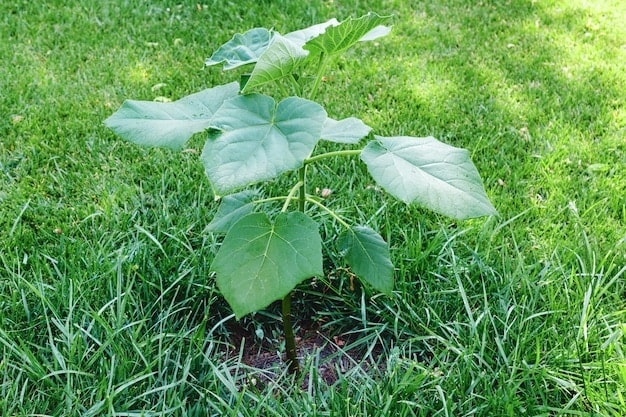
In fact, saplings grow as quickly as 2.5 meters each season. Thus, they’re often easily mistaken as gigantic weeds because of their thick stalks and large leaves.
In its first year, it can reach up to 15 feet high. Its growth begins to slow down as it matures, but they can extend to about 30 to 40 feet in height.
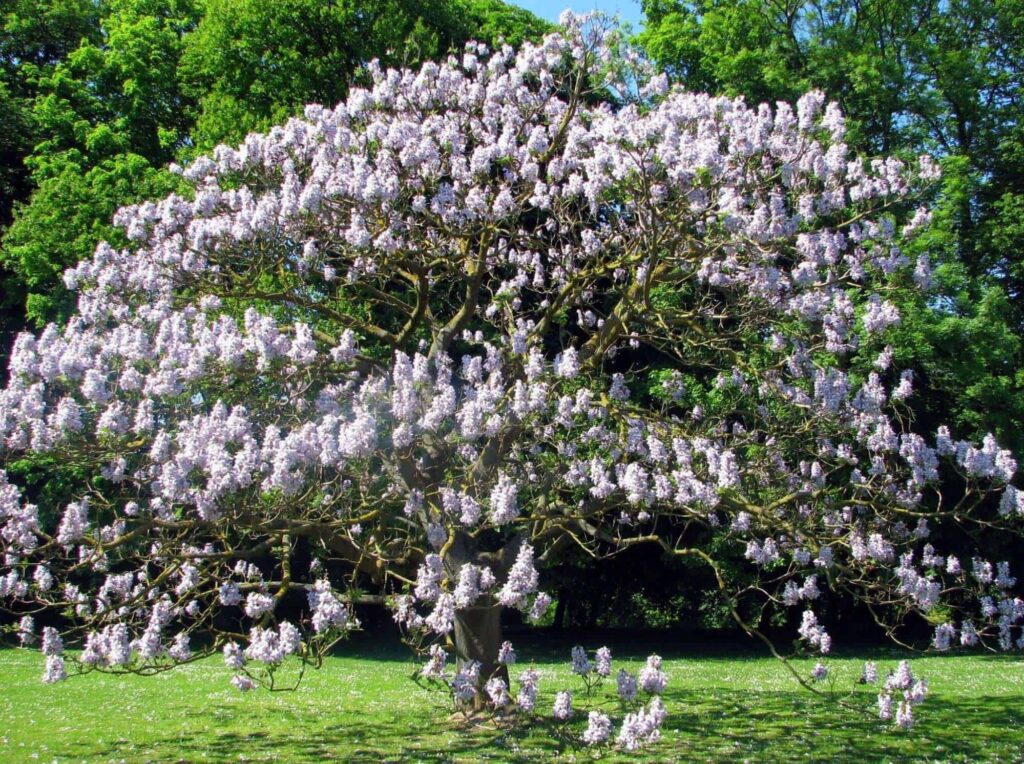
It originated in Central and Western China along with the Korean Peninsula. Hence, it’s abundant in Asian history for its medicinal properties and appearances in traditional folklore.
Its wood is also a popular option for woodworking as it’s quite resilient to moisture. Hence, carpenters won’t need to worry about long-term warping or splitting.
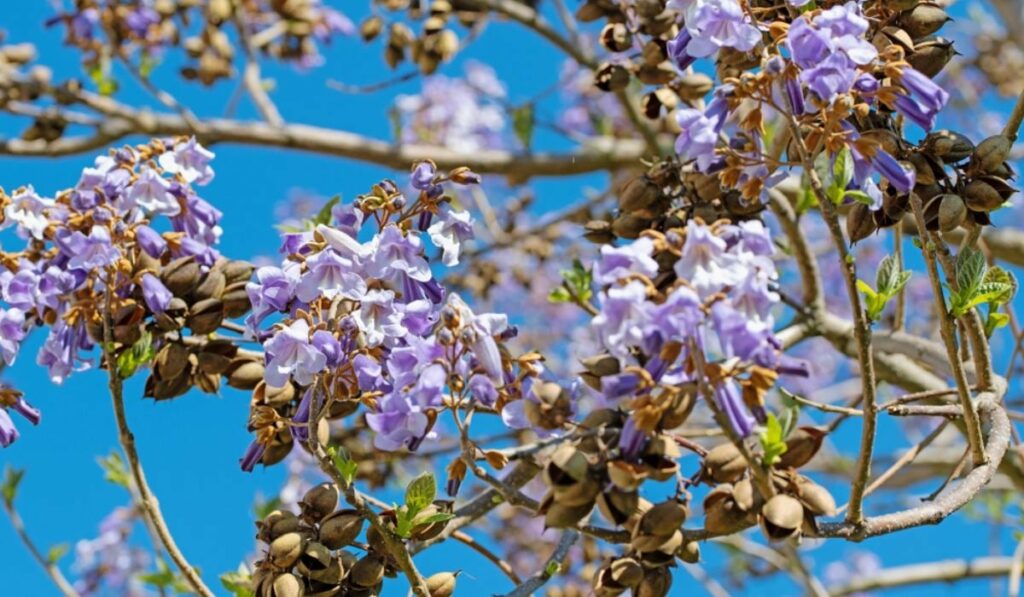
In Asia and many other parts of the world, the paulownia tree is used as a decorative plant. This is primarily because it’s a flowering tree, which is definitely a sight to see when in full bloom.
Despite coming in about 17 varieties, they only produce blue-yellow, lavender, or pink colored flowers that grow only to a couple of inches. Unfortunately, you’ll only be able to see flowers for only 2 to 4 weeks out of the whole year.
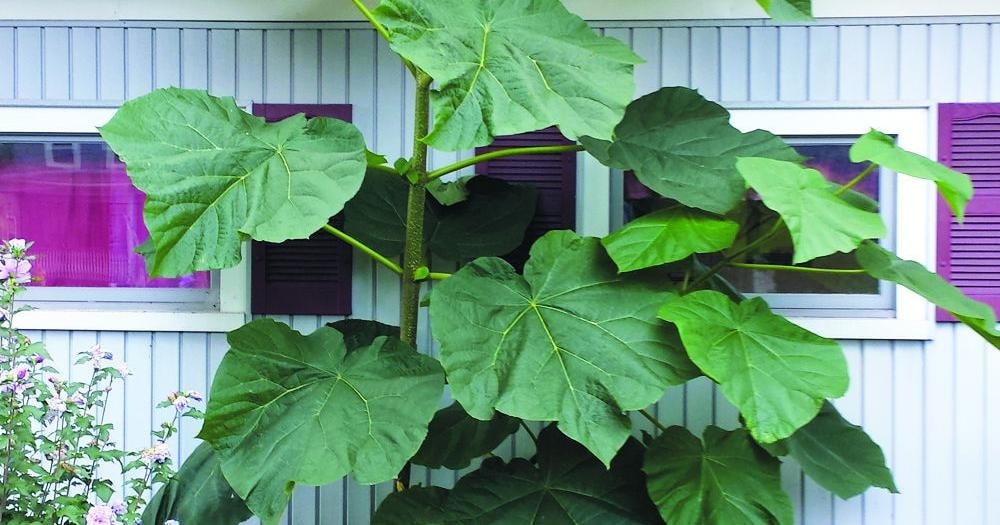
Though, since the paulownia tree is considered a weed in many places, here are a few ways that you can eliminate them from your property:
How do I remove paulownia?
#1 Uproot the saplings
Since seeds can only come from a mature paulownia tree that has flowered, the best way to manage its population is to uproot the saplings as soon as possible.
- Gently loosen up the soil to ensure that you can pull the sapling out as a whole. You can use sticks and gardening tools to help you out.
The best time to uproot a sproutling is after a generous rainfall as the soil is quite loose, preventing resistance.
- Carefully hold onto the sapling and delicately pull it from the soil. If the plant is showing some resistance, loosen the soil a bit more as you don’t want any roots to snap off and get left behind.
- Once you’ve gotten the paulownia tree out, perform a quick check to ensure that you’ve gotten every fragment of the root out to ensure that it doesn’t grow back again.
#2 Girdle the tree
If the paulownia tree has already matured and uprooting is no longer an option, you can girdle it.
Do note that girdling or ring barking is a relatively slower method of removal. In fact, it could take at least a year or two depending on the size of the tree and extent of its root system.
- Firstly, locate the area where you’ll remove the bark. To do so, measure approximately 6 inches or 15 centimeters from the ground and encircle the base of the trunk.
- Use a hand saw, sharp drawknife, hatchet, or a chainsaw to thoroughly cut through the bark.
Ensure that you’ve cut deeply enough through the cambium layer to prevent bark regrowth.
- After successfully removing these layers from the tree bark, apply herbicides or foliar sprays.
#3 Cut-stump method
The cut stump method is another alternative for when uprooting is no longer an option. However, it’ll require that the tree must be cut until only the stump is left.
It’s also important to note that the cut-stump method is a rather time-consuming technique. Hence, it’s not recommended for those in a hurry to remove the plant.
- Cut the paulownia tree until only its ground-level stump remains.
- Treat the stump with either a glyphosate (2% solution with 0.5% nonionic surfactant) or triclopyr (2% solution with 0.5% nonionic surfactant)
Alternatively, you can cover the stump with a dark-colored heavy-duty bag.
2. Pokeweed
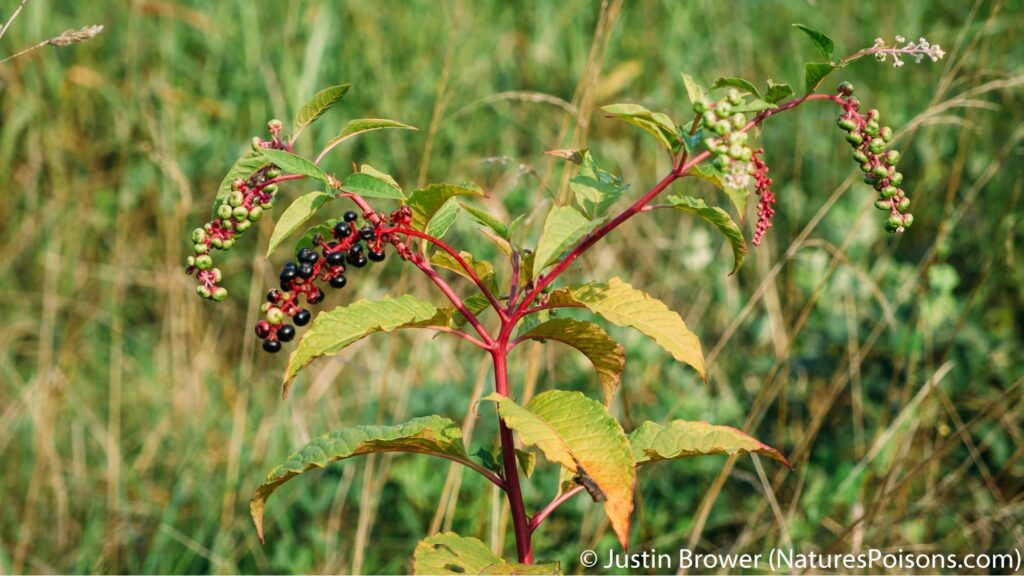
| Scientific Name | Phytolacca americana |
| Common Name(s) | PokeweedDragonberriesInkberry |
| Family | Phytolaccaceae |
| Nativity | North and Central AmericaThe Gulf Coast |
| Toxicity (Touch) | No |
| Toxicity (Ingestion) | Yes |
| Unique Characteristics | Grape-like berriesRed-purple colored stemSmall, white flowersGreen, lance-shaped leaves |
The pokeweed is unique for producing flustered grape-like berries during the summertime. As one of its most identifiable characteristics, they turn from a light green to a dark violet color when they ripen.
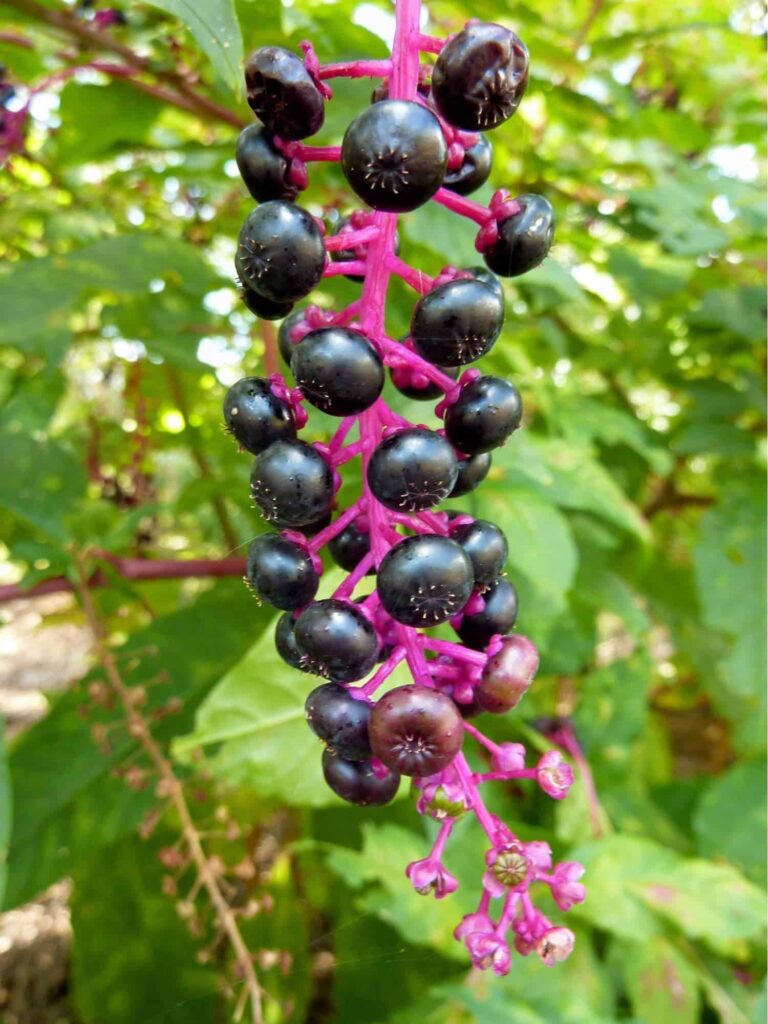
Since one plant can hold a ton of berries, it doesn’t come as a surprise that they can spread quickly. As a result, they’re known to obstruct the natural ecosystem of native flora.
It’s also important to highlight that these berries are highly toxic to both humans and animals, especially as they get older. Hence, it’s important to keep pets, livestock, and children away.
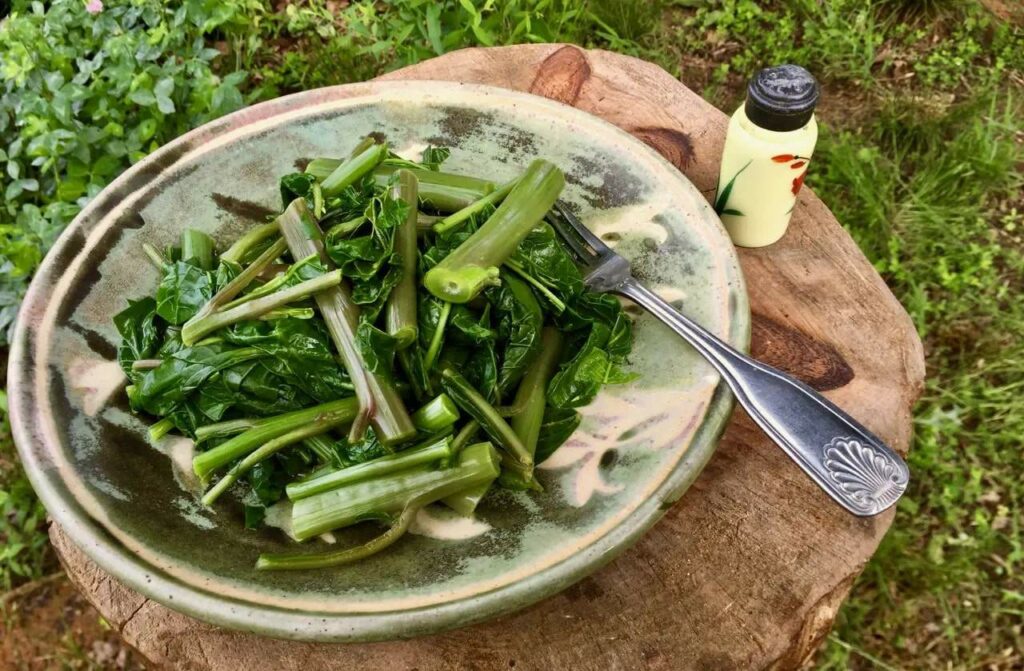
While their leaves are known to have triggered allergic reactions in some, they’re considered edible in some parts of the world. In fact, ‘poke sallet’ is a relatively famous dish composed of the cooked leaves and young shoots.
Another unique characteristic about the pokeweed is that it has a thick red-purple colored stem. It also has green, lance-shaped leaves and small, green-white flowers.
When matured, they can grow anywhere from 2 to 10 feet tall and about 2 to 3 feet wide.
While its size makes it seem to be a relatively easy weed to deal with, its hidden strength lies in its ability to deeply root itself to the ground.
Because it grows such a large taproot, manual hand-pulling won’t work with this weed. Instead, you’ll need to either remove the whole plant completely or resort to chemical solutions.
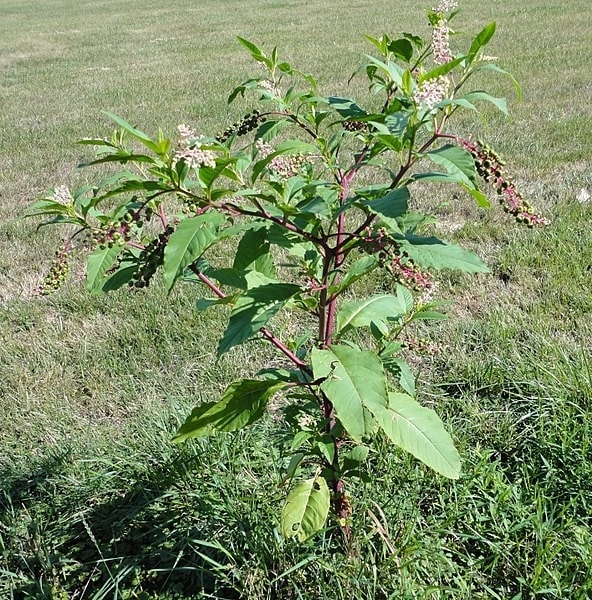
Given their toxicity and harm to natural flora, it may be in your best interest to get rid of pokeweed plants as early as possible. If you spot a pokeweed plant on your property, here are a couple of ways you can remove it.
How do you safely remove pokeweed?
#1 Dig up the pokeweed plant
- Manually dig around the pokeweed plant to ensure that you can dig around the roots so as not to damage it.
- Carefully untangle the roots so that you can dig out the plant any roots breaking off.
- After you’ve successfully removed the plant, scan the area for any remaining root fragments that could grow again into a new pokeweed.
#2 Shower the leaves in a glyphosate-based solution
- Wear protective gear such as a face mask, gloves, goggles, pants, and a long-sleeved shirt in preparation for using this herbicide.
- Carefully spray just the leaves with a glyphosate-based solution on a sunny day when rain isn’t expected.
Because glyphosate is known to harm all plants it comes across, ensure that you only cover the plants you want to get rid of.
- Leave the herbicide to do its job for several hours before spraying the pokeweed again.
3. Sunflower

| Scientific Name | Helianthus annuus |
| Common Name(s) | Wild sunflowerCommon sunflower |
| Family | Asteraceae |
| Nativity | CanadaU.S.A.Northern Mexico |
| Toxicity (Touch) | No |
| Toxicity (Ingestion) | No |
| Unique Characteristics | Hairy heart-shaped leaves Bright yellow-colored leaves that encircle a dark brown-colored center |
While it may be quite the surprise that the beloved sunflower is on this list, they’ve actually considered weeds in some areas as they tend to pop up out of nowhere.
In fact, a single sunflower head which is about 12 inches in diameter can hold up to 2,000 seeds. Hence, they can easily be dispersed through animals, wind, and water.
Despite being native to the U.S.A., they’re considered noxious weeds (i.e., weeds that are harmful to the environment or animals) in states such as Iowa.
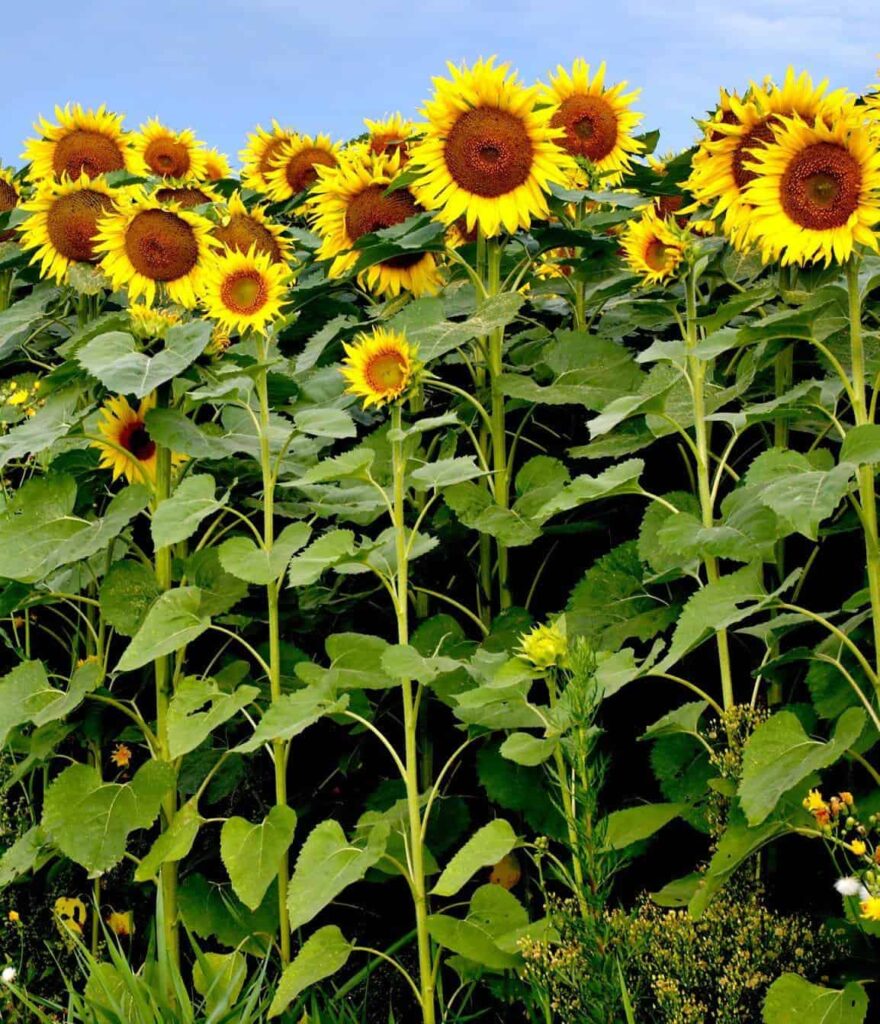
Sunflowers are easily identifiable because of their bright yellow-colored leaves that encircle their dark brown-colored center.
They’re also known to reach heights of about 8 feet tall. Depending on the species of sunflower, they can either have a single or branched stem.
Their large, heart-shaped leaves are also considered unique characteristics. They have rough hairs all over and grow to about 3 inches to nearly a foot in diameter.
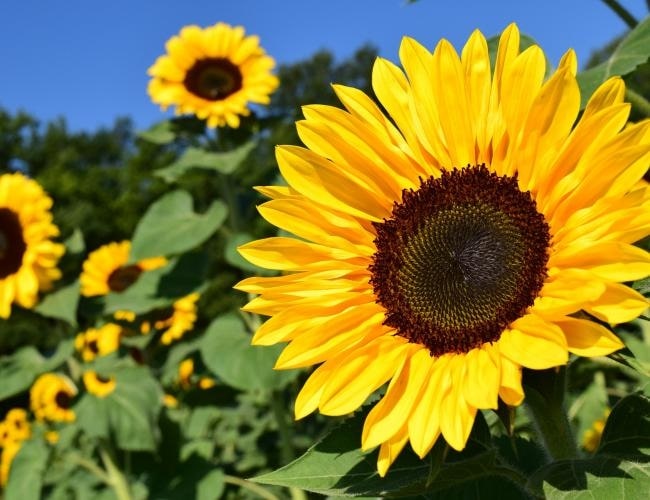
Even though deemed weeds by some, they aren’t as difficult to get rid of. Actually, some may argue that they add character to an otherwise plain-looking garden.
Nevertheless, if they aren’t your cup of tea to have on your property, you can easily get rid of them using the following methods.
How to get rid of sunflowers
#1 Uproot the sunflower
- Cover the sunflower head with a plastic bag to ensure that the seeds don’t disperse while you’re trying to uproot it.
- Loosen up the soil with a stick or available gardening equipment. This way, it’ll be easier to uproot the sunflower.
If there are any root fragment remnants, you can dig them out with a spade. You’ll want to remove as much of the leftover roots as possible to avoid regrowth.
#2 Spray the foliage with weedkiller
- Put on protective gear such as gloves, goggles, and appropriate clothing before handling any chemical controls.
- Carefully spray the sunflower plant with weedkiller to avoid accidentally getting any chemicals on plants that you want to keep.
4. Ricinus

| Scientific Name | Ricinus communis |
| Common Name(s) | Castor beanCastor oil plant |
| Family | Euphorbiaceae |
| Nativity | AsiaAfrica |
| Toxicity (Touch) | No |
| Toxicity (Ingestion) | Yes |
| Unique Characteristics | Woody stem that changes from red to a deep purple-red as it agesSpiky green or purple-red fruits |
The ricinus plant is also most commonly referred to as the castor bean plant. This is because it’s primarily grown for its beans which are used to make castor oil, which is used for several industrial purposes.
It’s widely considered an invasive weed in several areas, such as in the Southwestern U.S and in the tropics. In fact, it’s often spotted overtaking fields, roadsides, and any available land in its midst.
It’s a problematic plant to have around because its leaves and seeds contain the toxin named “ricin”. This is poisonous to both humans and animals so it’s best to rid your property of this weed.
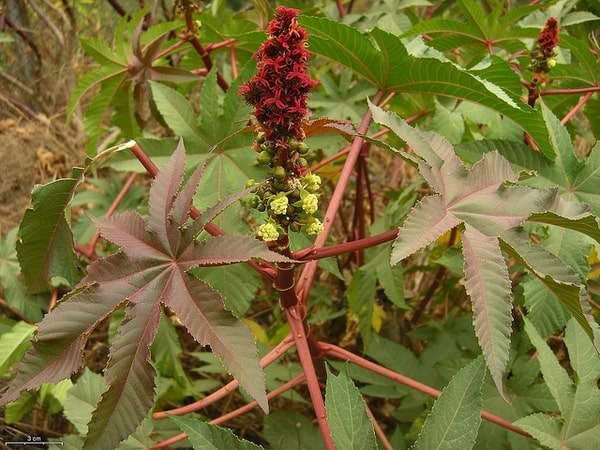
They have thick, woody stems that are usually a reddish-brown color. As it ages, it changes to a reddish-purple hue.
It’s also known to have big, glossy leaves that spread out like a palm with 5 to 11 fingers. There’s a distinguishable line that unites all of the leaves from the center of the palm to the tip of each leaf.
When young, the leaves are a deep reddish-purple color that turns green over time as the plant matures.
It’s also unique for having spiny fruits that hold their bean-like seeds. These are usually located at the top of the stem and are green or purple-red in color.
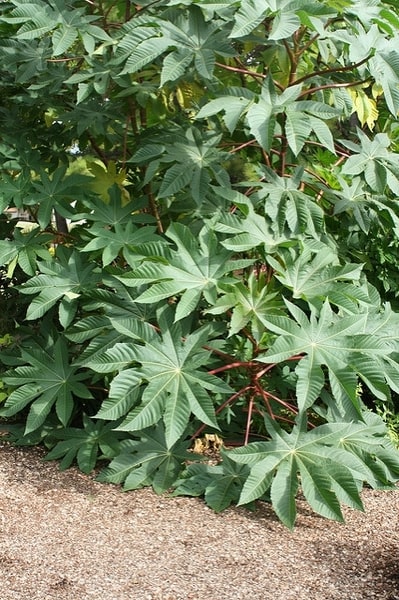
Given their problematic nature, it’s no surprise that many want to get rid of this weed as soon as possible. Luckily, it’s relatively easy to do.
How do you get rid of castor bean plants?
Uprooting the plant
- Wear protective gear such as gloves, goggles, a long-sleeved shirt, and pants before handling the plant.
- Loosen up the soil by using gardening tools such as a shovel to dig around the root structure.
- After, grasp the stem of the castor bean plant well and gently wiggle it out of the ground. You’ll want to do this gently so as not to break off any of the roots.
- Once successfully pried from the ground, properly dispose of the plant. You can boil the plant in a large pot for about 30 to 45 minutes to get rid of the toxins.
Afterwards, bury the remains in the ground. Ensure that the hole is at least 40 inches deep to prevent any wildlife from digging it back up.
5. Japanese Knotweed
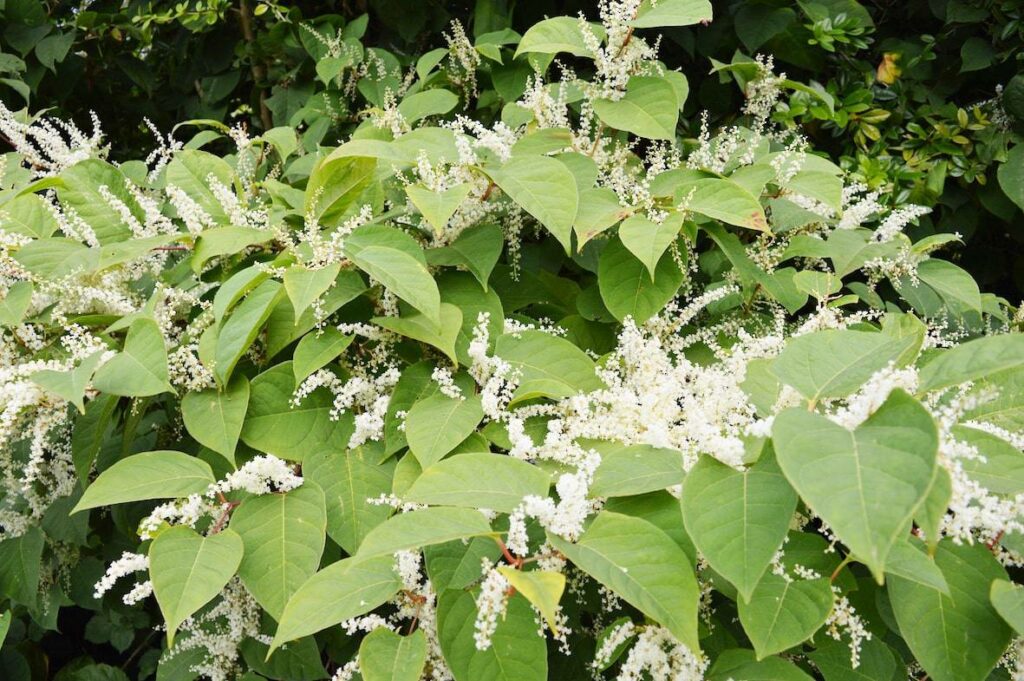
| Scientific Name | Reynoutria japonica |
| Common Name(s) | Asian knotweedJapanese bamboo |
| Family | Polygonaceae |
| Nativity | JapanChinaKorea |
| Toxicity (Touch) | No |
| Toxicity (Ingestion) | No |
| Unique Characteristics | Red, hollow bamboo-like stemsGreen, heart-shaped leavesSmall, cream-colored flowers |
Native to East Asia, the Japanese knotweed was introduced to the West in the mid-19th century where it became popular due to its resemblance to bamboo.
Aside from being a decorative plant, it was also widely appreciated for its culinary use. It can either be eaten raw or cooked, tasting similar to rhubarb.
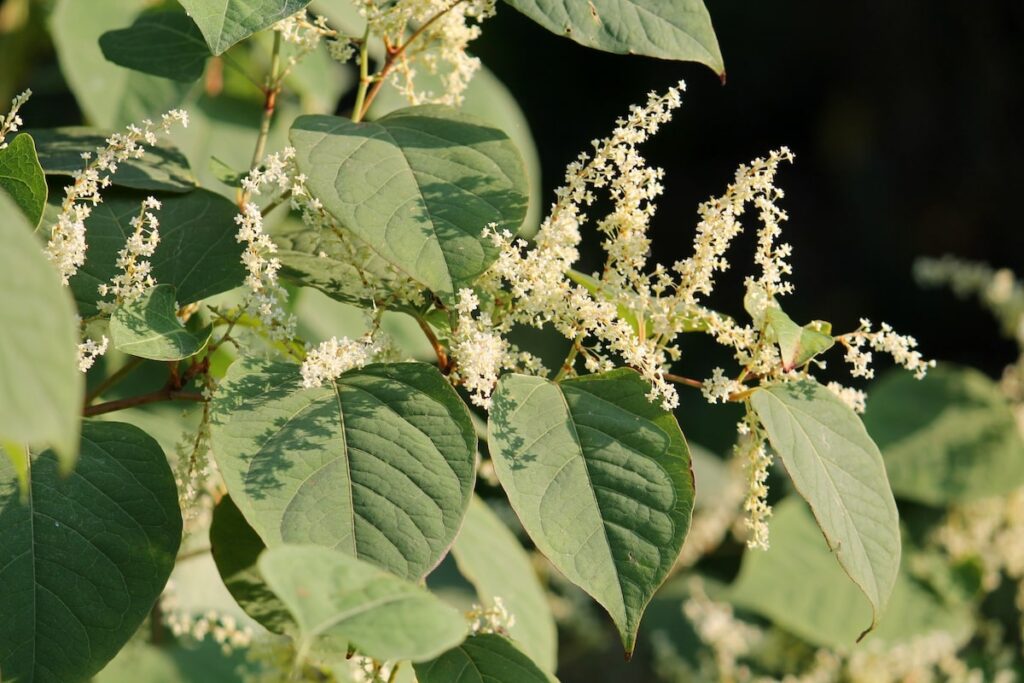
Unfortunately, it’s also notorious for being massively destructive. In fact, its large and thick extensive root system is known for wrecking landscapes and damaging property.
Because of how quickly and densely it grows, it poses a threat to native flora that can’t compete with them. Hence, they’re deemed noxious weeds in many states in the U.S.A.
Japanese knotweeds are identifiable because of their red, hollow bamboo-like stems that can grow to about 13 feet tall every season. Their green, heart-shaped leaves grow to about 2 to 7 inches long and are sometimes adorned with small, cream-colored flowers.
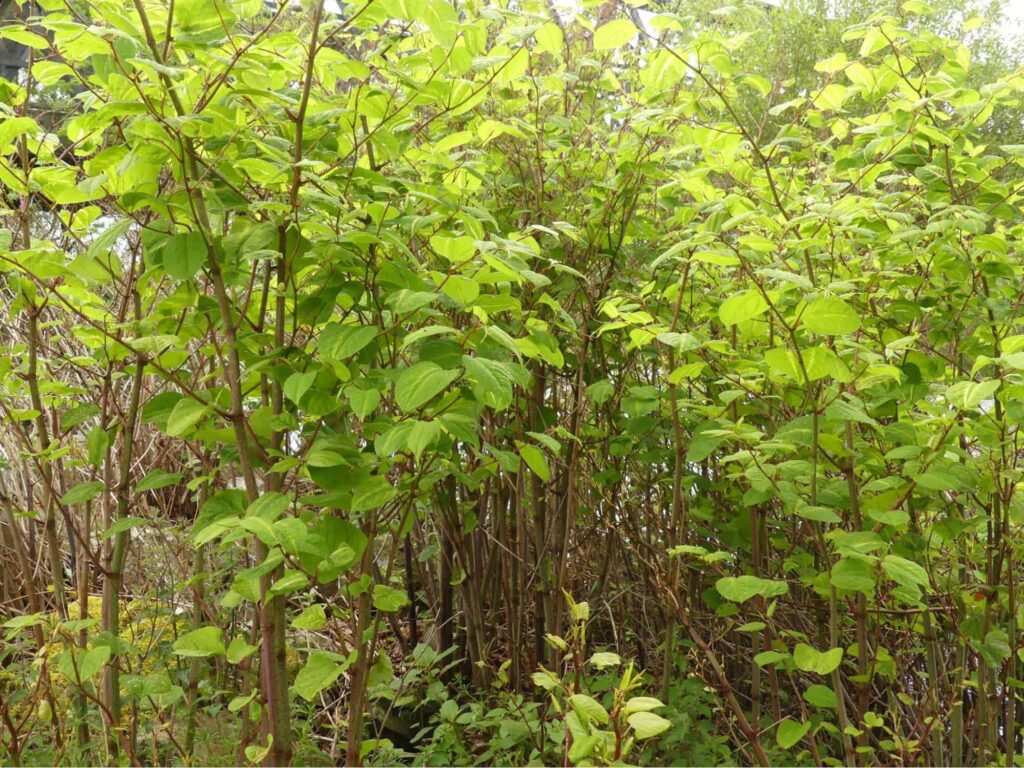
Given the trouble that comes with having Japanese knotweeds on your property, it’s recommended to take action quickly before its root system gets too deep.
It’s important to highlight that in certain areas, the Japanese knotweed is considered a controlled waste. Hence, it’s illegal to add them to your at-home compost or throw it in your council-run garbage bins.
Instead, they’re required to be disposed of at licensed landfills that possess the required paperwork.
Here are a few ways that you can safely remove Japanese knotweeds from your land.
What kills Japanese knotweed?
#1 Digging the plant out
- Clear the area surrounding the Japanese knotweed and gently till the soil to loosen it a bit.
- Hold the plant firmly and gently wiggle it out of the ground, being careful not to break apart its root system
- After successfully removing the plant, allow it to dry completely first before burning it.
#2 Spraying the plant with glyphosate-based weedkiller
- Protect yourself, first, by wearing gloves, goggles, and similar equipment before handling the weedkiller.
- Generously spray the leaves of the Japanese knotweed with a glyphosate-based weedkiller. Apply carefully as the glyphosate solution can harm surrounding plants.
Be sure to apply on a sunny day as you wouldn’t want the rain to wash away the solution before it can do its job.
Apart from that, ensure that you read the instructions properly as some weed killers prescribe instructions specifically for Japanese knotweeds.
- To increase effectiveness, create small cuts through the plant’s stem and roots. Then, apply a generous amount of weedkiller.
- Reapply if necessary to ensure complete eradication
#3 Hire professional removers
In the event that you cannot remove the Japanese knotweed on your own, you may want to hire professional removers instead.
6. Wild Lettuce
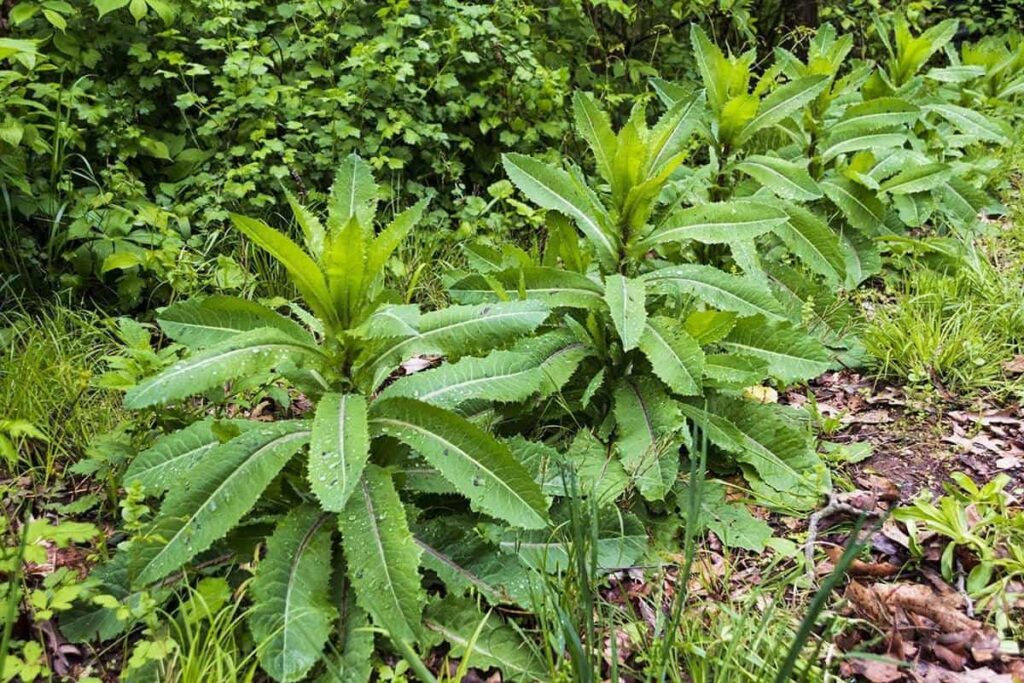
| Scientific Name | Lactuca virosa |
| Common Name(s) | Prickly lettuceBitter lettuceTall lettuceOpium lettuce |
| Family | Asteraceae |
| Nativity | EuropeNorth AfricaAsia |
| Toxicity (Touch) | No |
| Toxicity (Ingestion) | No |
| Unique Characteristics | Thick, stiff yet hollow stemsElongated, oblong-shaped leaves have serrated edges and tiny spikes all throughoutMilky, potent sap |
As its name suggests, the wild lettuce is exactly that – the lettuce of the wild. Despite being more bitter than commercial lettuce, it actually has higher nutritional value and medicinal properties.
However, it’s also widely considered a weed in various parts of the world because of how large they grow. Nonetheless, they’re biennial plants which means they only grow every other year.
Known to grow thick, stiff yet hollow stems, it can actually grow to about 8 feet tall in the right growing conditions. Depending on the variety, its stem can be various colors of grayish-green, brownish-red, green, or purple.
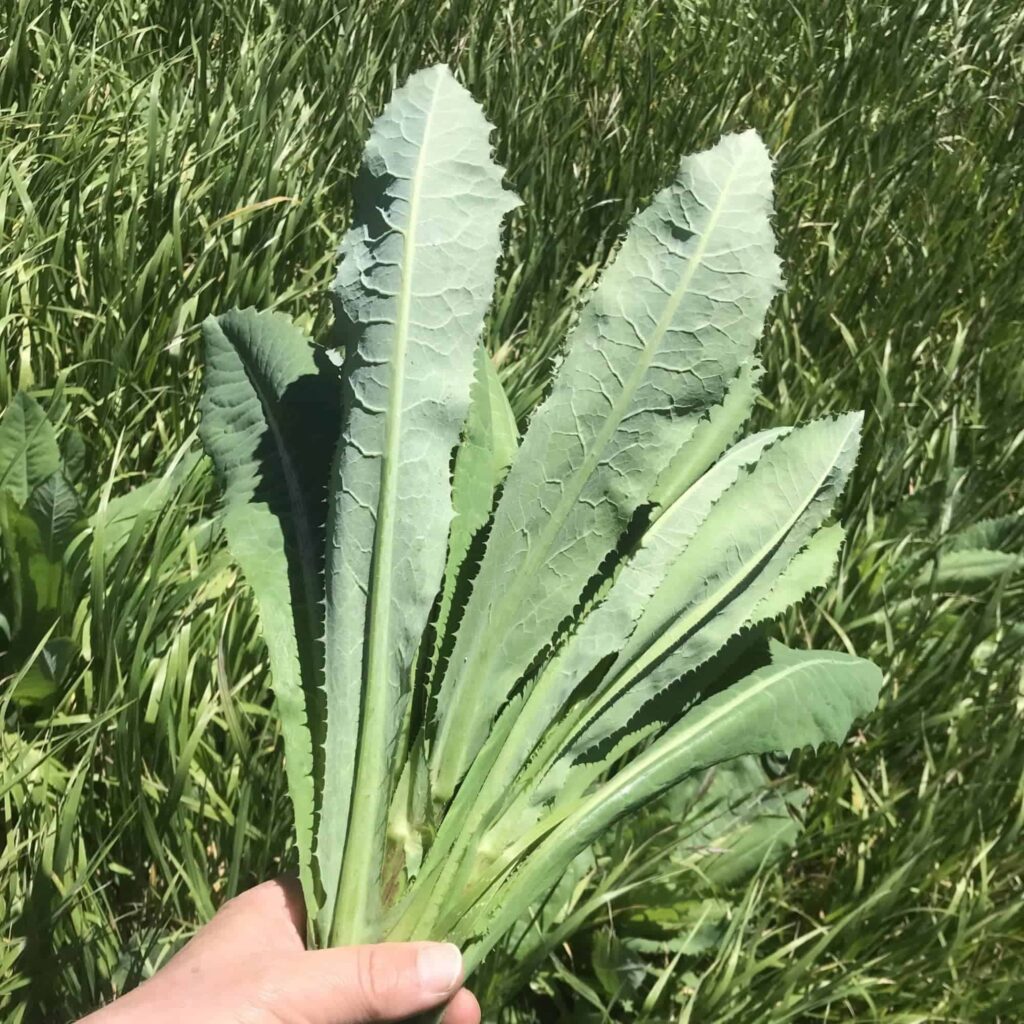
When cut, it releases a milky but potent sap that’s commonly used for pain relief because of its sedative and analgesic properties.
The wild lettuce forms a rosette of leaves starting from the base upward. Its elongated, oblong-shaped leaves have serrated edges and tiny spikes all throughout, which is also why it’s referred to as “prickly lettuce”.
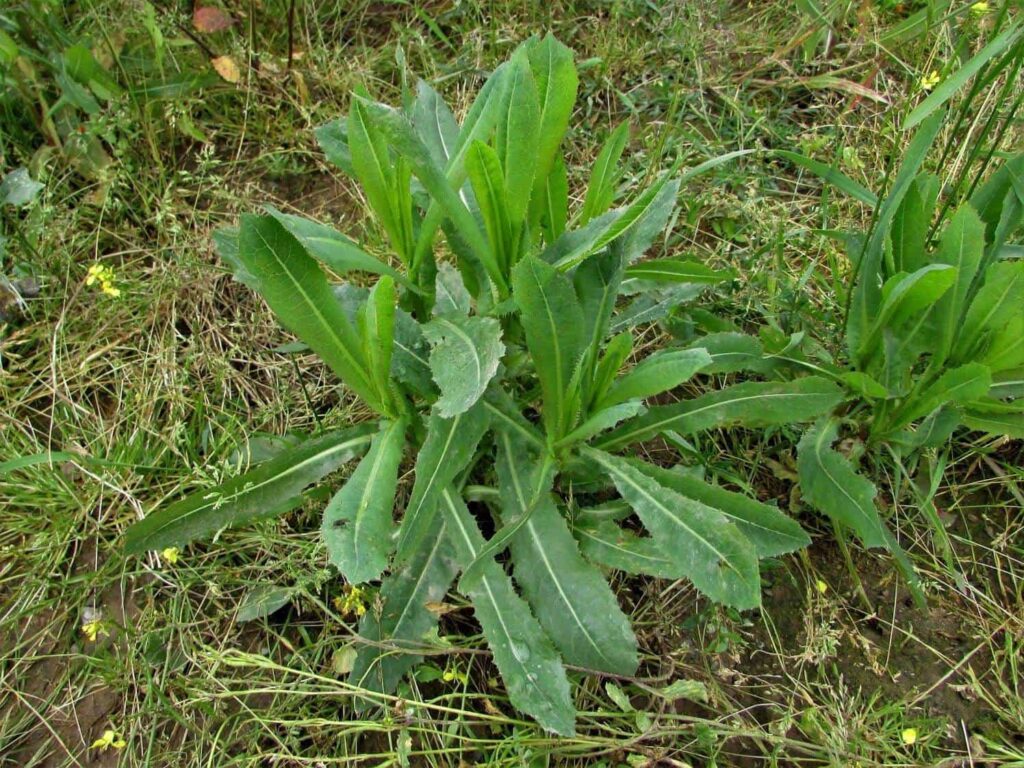
Though, if you don’t plan on using the wild lettuce in the kitchen or utilizing its medicinal properties, it can definitely be an eyesore. So it’s no surprise that many would rather remove it from their garden.
How to get rid of wild lettuce
#1 Herbicidal control
- Put on protective equipment such as a face mask, gloves, goggles, and full-coverage attire before handling herbicides.
- Generously cover the plant with herbicides that contain either glufosinate or paraquat before the plant has begun flowering.
For a more organic herbicide alternative, opt for variants that include clove oil (eugenol).
- Reapply as prescribed by the instructions on the packet.
#2 Manual hand pulling
- Wet the soil and gently loosen it up with a stick or spade.
- Gently remove each plant ensuring that you don’t break off any of its roots.
#3 Animal grazing
Let livestock such as sheep and goats devour the wild lettuce.
7. Giant Hogweed
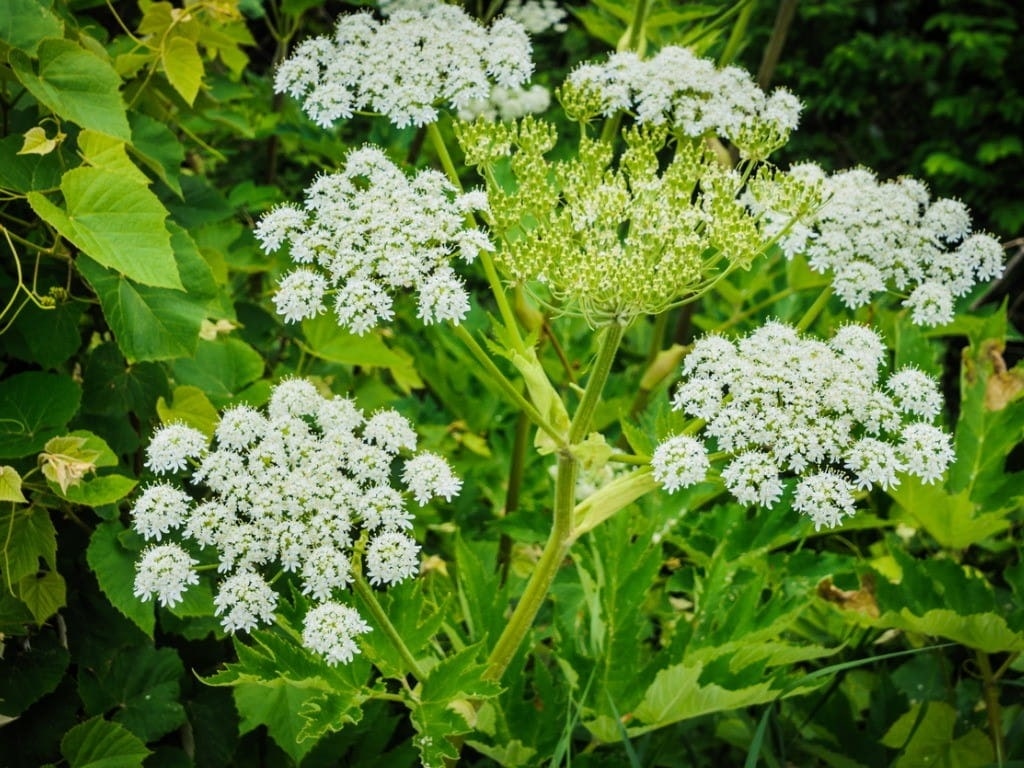
| Scientific Name | Heracleum mantegazzianum |
| Common Name(s) | Cartwheel-flowerGiant cow parsleyGiant cow parsnipHogsbaneWild parsnipWild rhubarb |
| Family | Apiaceae |
| Nativity | Southwest Asia |
| Toxicity (Touch) | Yes |
| Toxicity (Ingestion) | Yes |
| Unique Characteristics | Thick, green and purple stem that’s covered in dark reddish-purple bumps and prickly, white hairsLarge, green, lobed leavesInflorescent, green and white flowers at the top of its stem |
The infamous giant hogweed is truly a force to be reckoned with. It’s definitely one of the largest weeds on this list, growing to as tall as 18 feet high when in the right growing conditions.
Its green and purple stem grows to about 2 to 4 inches in diameter and is covered in dark reddish-purple bumps and prickly, white hairs. Its green, lobed leaves are also quite large, growing to about 3 to 5 feet wide.

Aside from its size, it’s heavily disliked for its ability to cause serious burns, blisters, and permanent scarring when skin comes in contact with its sap.
In fact, it’s even banned in several areas to sell, import, propagate, and transport. There are states that even require homeowners to control the presence of giant hogweed on their land.
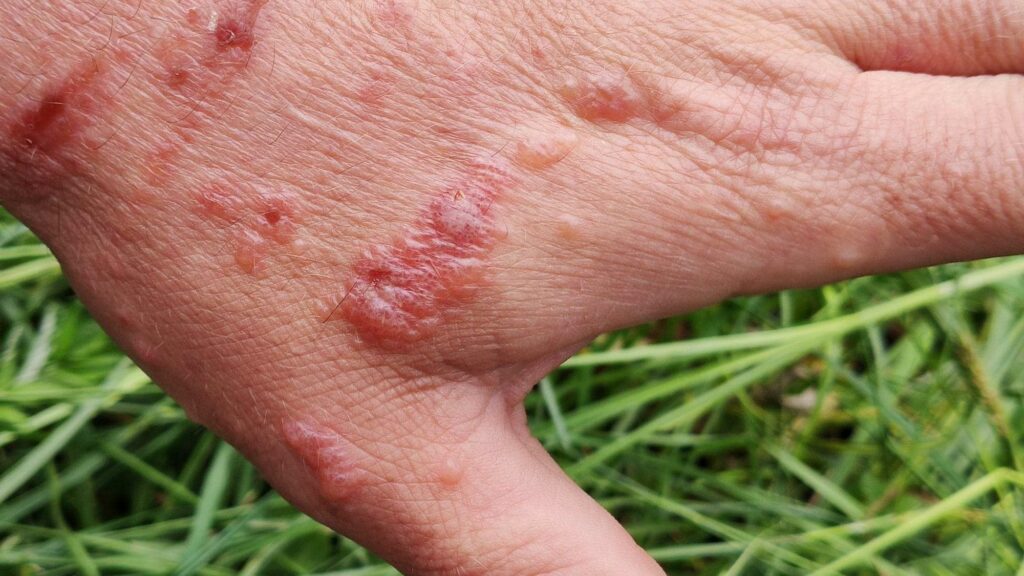
When in bloom, it grows inflorescent, green and white flowers at the top of its stem that kind of resemble an umbrella. From end to end, its flower head grows to about 2 ½ feet.
Despite originally being a sought after ornamental plant in various countries, it has since earned itself a spot on several noxious weed lists.
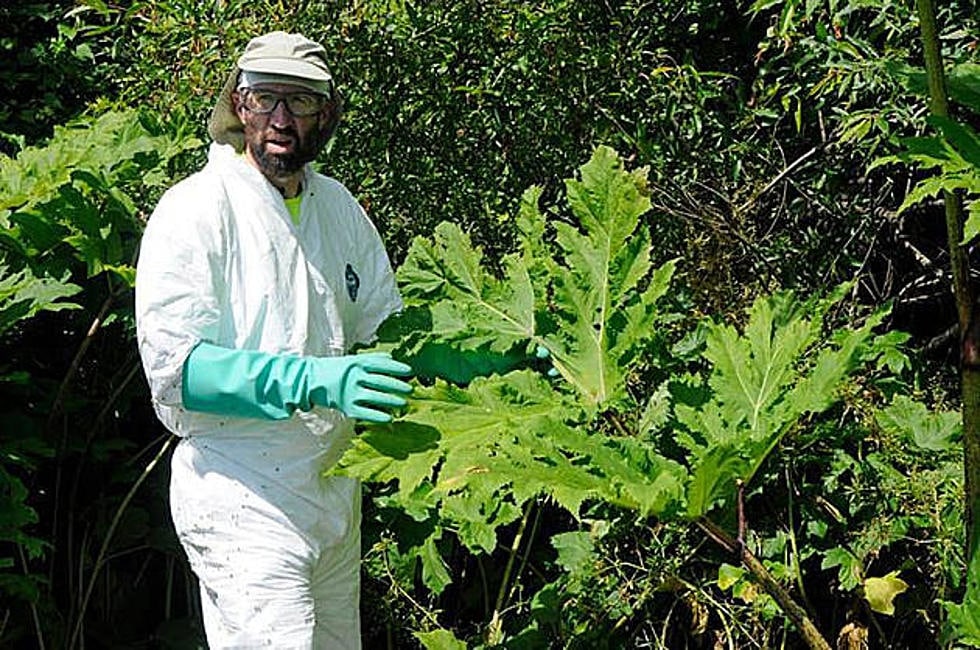
It’s important to note that the giant hogweed is considered controlled waste. Hence, you’re prohibited from disposing it anywhere else aside from a licensed landfill site with the necessary documentation.
If you’ve spotted a giant hogweed plant growing on your property, here are a few ways to safely handle it:
How do I get rid of giant hogweed?
#1 Cut the roots
This method works best with small infestations. It’s also recommended to be performed when your hogweed plant hasn’t matured yet.
- Secure protective gear such as gloves, goggles, and attire that fully covers your skin before handling the plant.
- Loosen the soil by adding water and gently prodding at it with a stick or shovel.
- About 6 inches below the ground level, cut the growing point. Note that it may be necessary for you to recut the growing point several times within a single season.
#2 Spray generously with a glyphosate-based weed killer
- Wear protective gear such as a face mask, gloves, goggles, and attire that fully covers your skin before handling the plant.
- Generously spray a glyphosate-based weed killer all over the leaves of the entire weed. Note that for best results, use this weed killer before flowering and on a sunny day.
- Continuously monitor and reapply if necessary. If new seedlings emerge, simply respray with the weed killer.
#3 Contact your local council
In some areas, local councils have field crews that can remove hogweeds for their residents. The method may vary depending on the size of the infestation.
Field crews may utilize root-cutting techniques or herbicides. They may also remove all of the flower heads to limit seed dispersal.
Afterwards, the site will be visited and monitored for a few years to ensure successful removal.
8. Creeping Thistle

| Scientific Name | Cirsium arvense |
| Common Name(s) | Canada thistleField thistleCurst thistle |
| Family | Asteraceae |
| Nativity | EuropeWest AsiaNorth Africa |
| Toxicity (Touch) | No |
| Toxicity (Ingestion) | No |
| Unique Characteristics | Tall, smooth, thick, stalksIrregularly lobed, lance-shaped leaves with small spikes |
The creeping thistle is actually well-known for its medicinal benefits. It’s widely used as a remedy for toothaches, indigestion, and rheumatic joint paints, among other ailments.
However, it’s considered invasive as it’s notorious for spreading indiscriminately and aggressively in virtually any environment that it’s in.
To make things worse, their seeds disperse quickly as they’re quite small and can be easily carried away by the wind.
Because it’s able to establish its roots early on, it’s also able to withstand harsh chemical treatments. Hence, it’s quite difficult to get rid of.
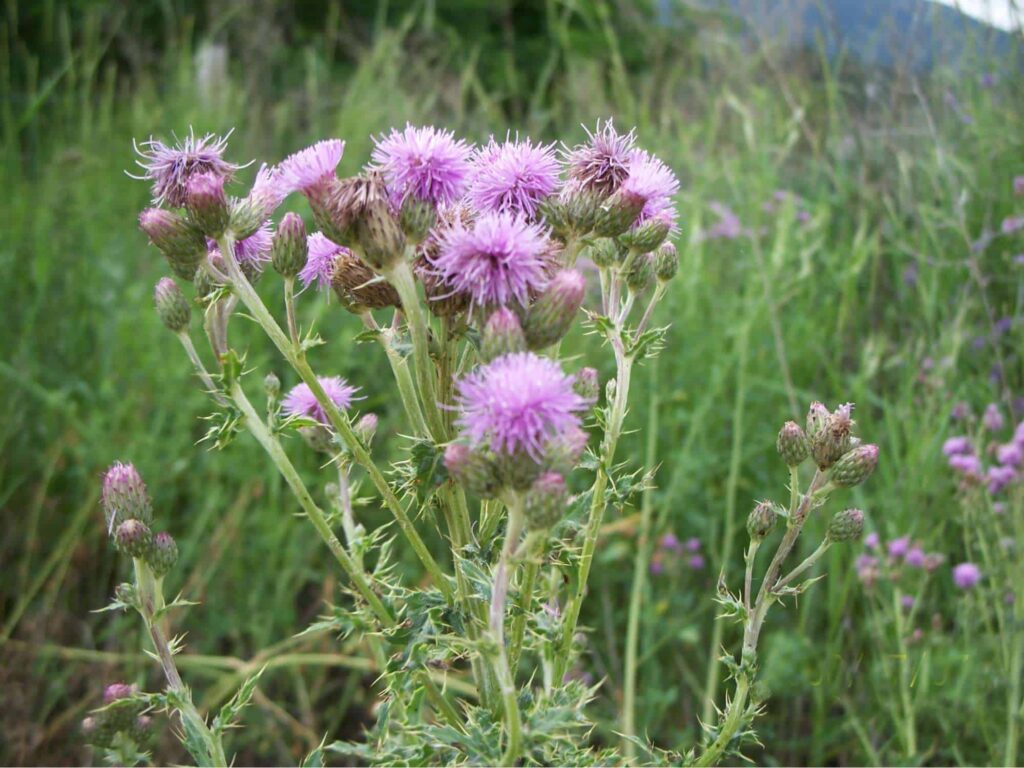
They’re distinguishable for their green, teardrop-shaped buds that sprout pink-purple flowers at the very top. Their buds usually are about ½ inch wide and 1 inch long.
These grow on tall, smooth, thick, stalks that grow to about 5 feet in height, developing several shoots as it expands.
Its lance-shaped leaves are irregularly lobed and are quite spiky as they have several thorns. They’re the largest at the bottom half of the plant, growing to about 20 centimeters long and 3 centimeters wide, gradually getting smaller towards the upper half.
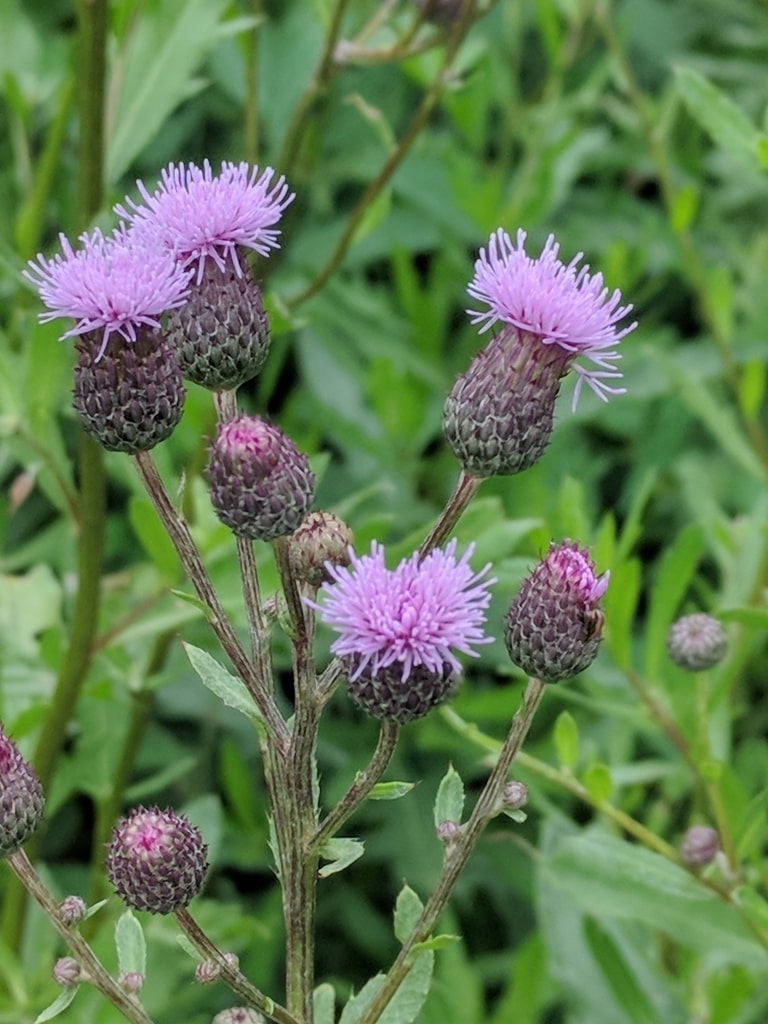
While the creeping thistle is not widely considered toxic, there have been reports of itchy, allergic reactions from direct skin contact.
Even then, it’s actually edible as long as you remove the spines and peel off the skin. It can either be eaten raw or cooked and has a relatively bland flavor.
Many who don’t use the creeping thistle plant for its medicinal or culinary use often just get rid of it. If you’re planning to do the same, here are a few methods that you can apply.
How do you get creeping thistle out from the ground?
#1 Dig them out
- Wear protective gloves and a long-sleeved shirt to avoid any accidental direct contact that could elicit an allergic reaction.
- Dampen the soil with water and loosen it with a fork, weeding tool, or any other gardening equipment.
- Lightly tug on the plant, removing it as carefully as possible to ensure that you pull out all traces of the root.
- After a successful extraction, perform a quick assessment of the area to ensure that no root fragments have been left behind or broken off.
#2 Generously apply horticultural vinegar
- Wear protective gloves and a long-sleeved shirt to avoid any accidental direct contact that could elicit an allergic reaction.
- Cut off the main stem about 2 to 3 inches above ground level.
- Dig a few holes by the base of the stem using a stick. For better results, ensure that you can properly see the roots.
- Generously apply horticultural vinegar around the entire area.
- For thistles that already have an established root system, reapplication may be necessary. Continuously observe and reapply horticultural vinegar every few days.
#3 Apply a glyphosate-based weed killer
- Wear protective gloves and a long-sleeved shirt to avoid any accidental direct contact that could elicit an allergic reaction.
- Cut off the main stem about 2 to 3 inches above ground level.
- Generously apply a glyphosate-based weed killer as per packaging instructions.
- Reapplication may be necessary for thistles with deep root systems. Ensure to observe any progress and reapply the glyphosate-based weed killer as prescribed.
9. Common Mullein
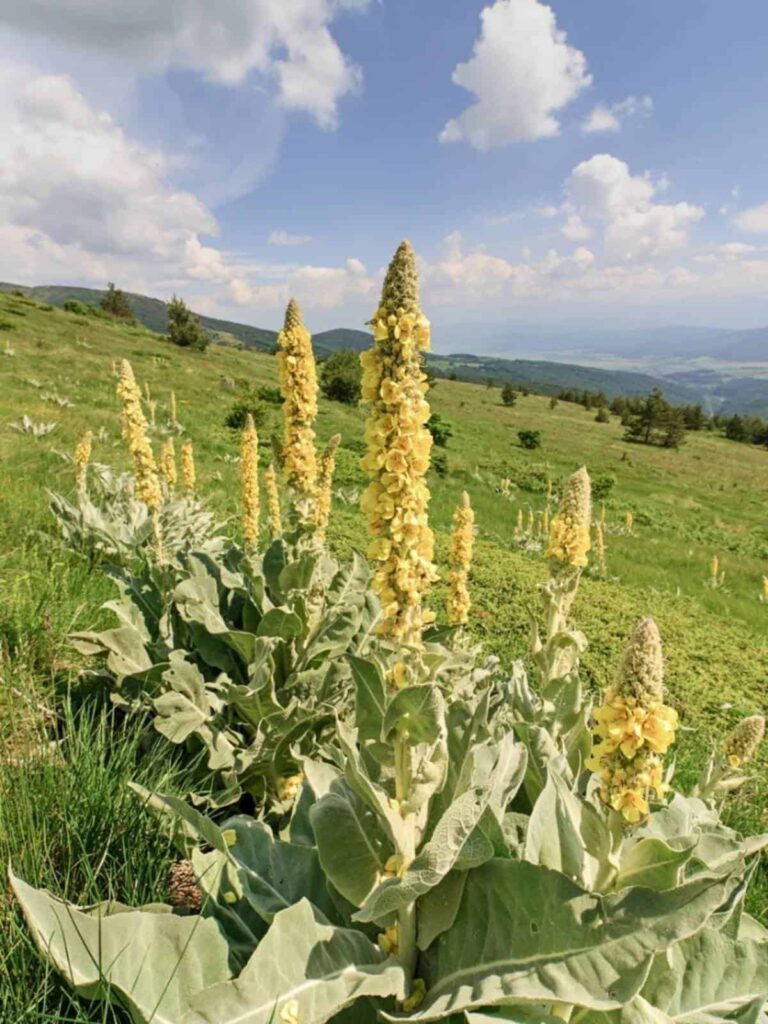
| Scientific Name | Verbascum thapsus |
| Common Name(s) | Aaron’s rodHagtapersAdan’s flannelOur Lady’s candleDonkey’s earsDuffleHare’s beard |
| Family | Scrophulariaceae |
| Nativity | EuropeNorth AfricaAsia |
| Toxicity (Touch) | No |
| Toxicity (Ingestion) | Some – SeedsNo – Leaves and flowers |
| Unique Characteristics | Tall, green stalk up to 6.5 feet highLight yellow flowers with pedicels |
With a comical appearance of what looks like a cross between a corn and cabbage plant, the common mullein is actually not a part of either family.
As a member of the Scrophulariaceae family, it’s a biennial plant native to Europe, North Africa, and Asia. In the early days, it was a popular herbal ingredient to treat bronchitis and coughs, among others.
In fact, its leaves were used to make tea during the Civil War. In the 1800s, early settlers used it to treat tuberculosis.
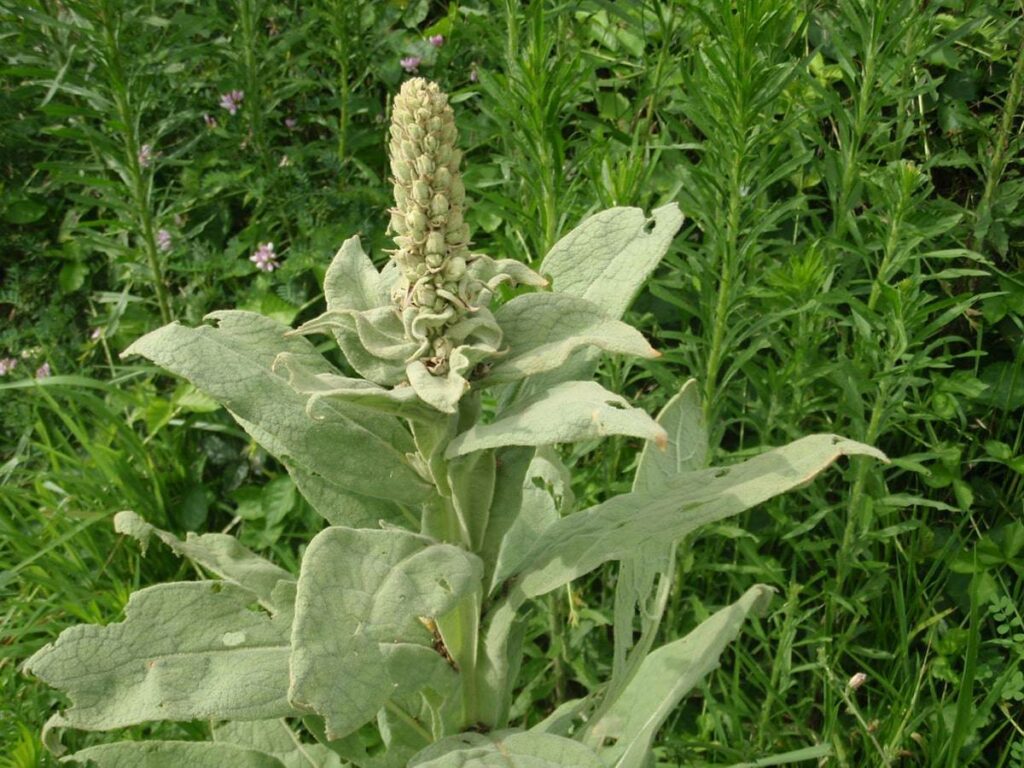
In its first year, it grows a rosette of green, velvety, ovate-shaped leaves around its base. Hence, it’s also sometimes funnily referred to as the “cowboy’s toilet paper”.
After another year of life, it develops a tall, green stalk that can grow as tall as 6.5 feet high. More ovate-shaped leaves grow on the stalk alternately.
At its peak is a dense cluster of light yellow inflorescence flowers that have small pedicels. The entirety of the plant is covered in little hairs, giving it a bit of a shine.
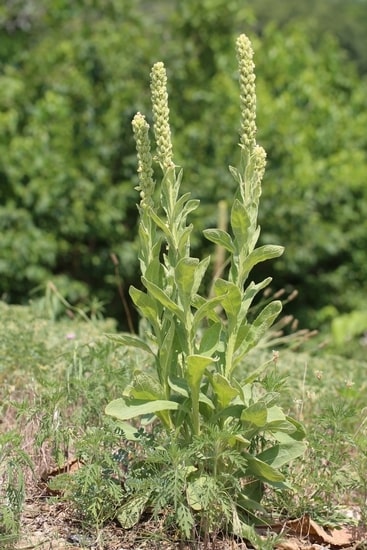
Other than its medicinal use, the common mullein serves no other purpose aside from occasionally being used as a decorative plant. More often than not, it’s deemed a noxious and invasive weed because of how quickly it disperses its seeds.
Hence, if they’re an unwanted plant on your property, here’s a couple of things you can do to get rid of them:
How do you get rid of common mullein?
#1 Handpull the plant
- Moisten the soil with water and loosen it up by carefully sticking a stick into the ground and wiggling it around.
- Get a good grip on the plant and gently tug it from the soil. Thankfully, they have pretty shallow taproots, which make for an easy extraction.
- Do a quick assessment of the area to ensure that you’ve gotten the entire root out and didn’t leave any fragments behind.
#2 Spray with a glyphosate-based weed killer
- Wear protective equipment such as a face mask and gloves before handling.
- Thoroughly apply the glyphosate-based weed killer onto the leaves of the plant as instructed. Be careful not to get the product onto nearby plants that you don’t want to harm
- Reapply as necessary for complete eradication.
#3 Feed to European curculionid weevil (Gymnetron tetrum) or the mullein moth (Cucullia verbasci)
- Release European curculionid weevil (Gymnetron tetrum) or the mullein moth (Cucullia verbasci) to the infested area.
- Allow the insects to feed on the common mullein plants and its seeds.
10. Himalayan Balsam
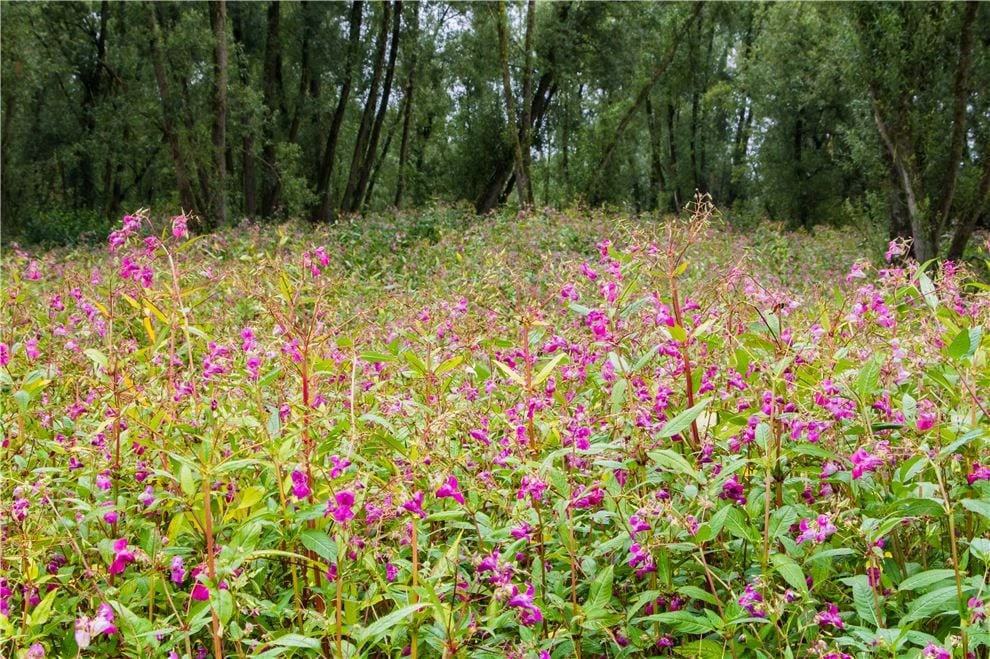
| Scientific Name | Impatiens glandulifera |
| Common Name(s) | Himalayan balsamPoliceman’s helmetKiss-me-on-the-mountain |
| Family | Balsaminaceae |
| Nativity | Himalayas |
| Toxicity (Touch) | No |
| Toxicity (Ingestion) | No |
| Unique Characteristics | Green-red stem that gradually thickens as it agesThin and lance-shaped with a pointy end and serrated edgesPink, purple, and white hood-shaped flowers |
Did you know that the Himalayan balsam is actually considered one of the UK’s most invasive weeds? It’s infamous for endangering native plant species and modifying the behavior of local pollinators.
Native to the mountainous region of the Himalayas, it was initially introduced to the rest of the world as an ornamental plant. However, it has since been considered a non-native invasive plant.
This is attributed to its unique seed dispersal method wherein its pods explode, launching the seed several feet into the air. As a result, the seeds are easily transported through wildlife, land, wind, or water.
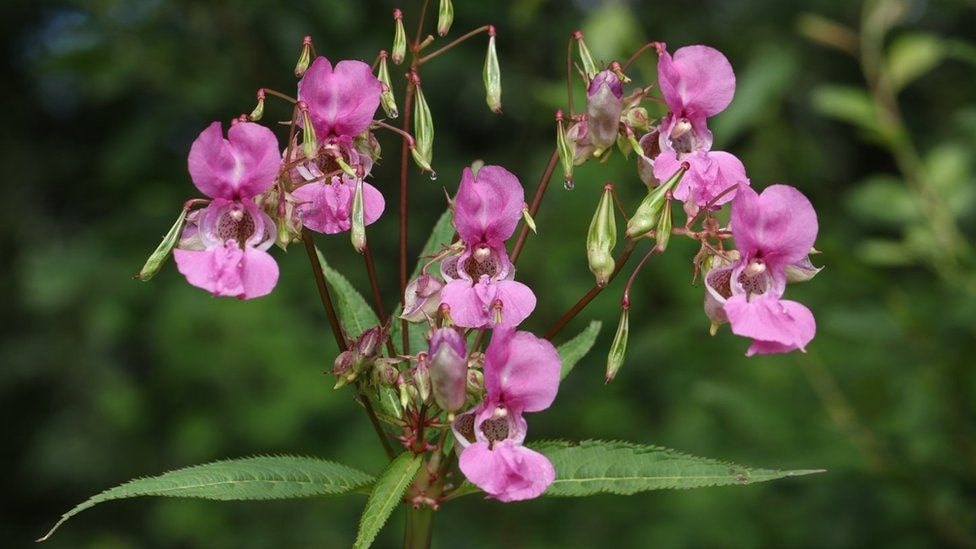
The Himalayan balsam is an annual herbaceous plant that can grow to heights of up to 6.5 feet. It has a green-red stem that gradually thickens as it ages.
Meanwhile, its leaves are thin and lance-shaped with a pointy end and serrated edges. It grows a mix of pink, purple, and white hood-shaped flowers, which earned it the nickname “policeman’s helmet”.
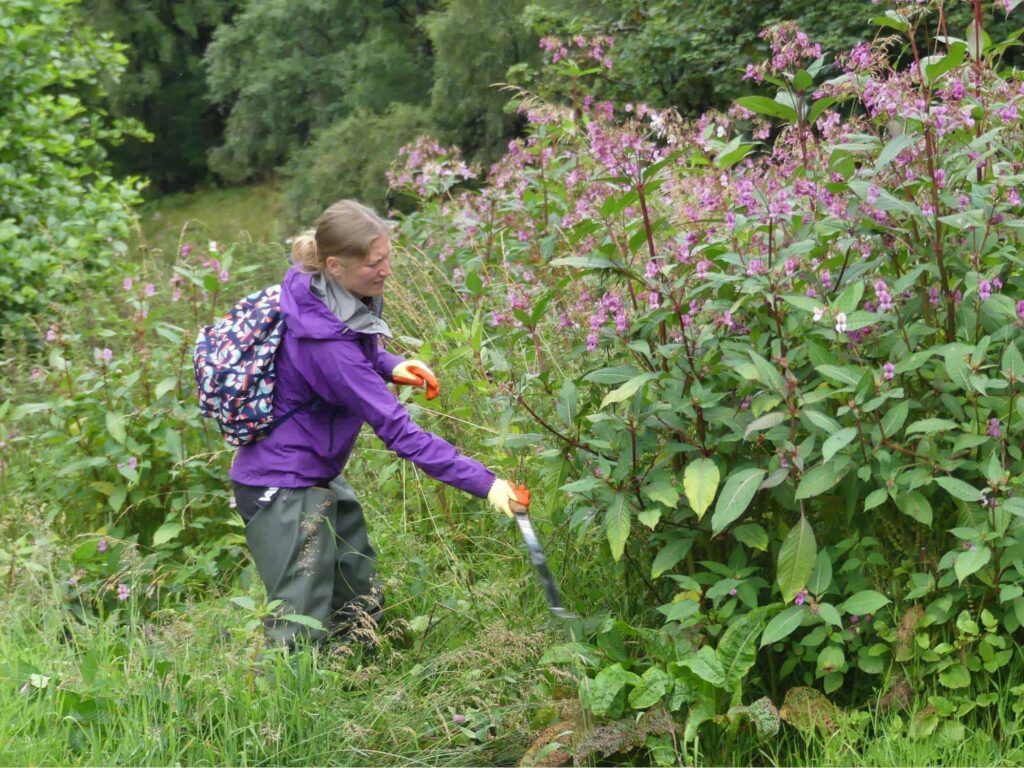
If you aren’t keeping your Himalayan balsam as a decorative plant, you might as well remove it from your garden to prevent it from taking all the nutrients from nearby greenery.
How do you stop Himalayan balsam from spreading?
#1 Hand pull the plant
- Loosen up the soil by adding a bit of water and pulling it apart with a stick or weeding fork.
- Gently grasp the base of the plant and pull upwards, releasing it from the soil. Since it has quite shallow roots, it should easily detach itself from the ground.
#2 Spray with a glyphosate-based weed killer
- Wear protective gear such as a face mask, gloves, and long-sleeved shirt before handling.
- Spray the foliage with a glyphosate-based weed killer according to the instructions before the plant begins to flower.
- Observe and reapply as needed.
11. Giant Ragweed
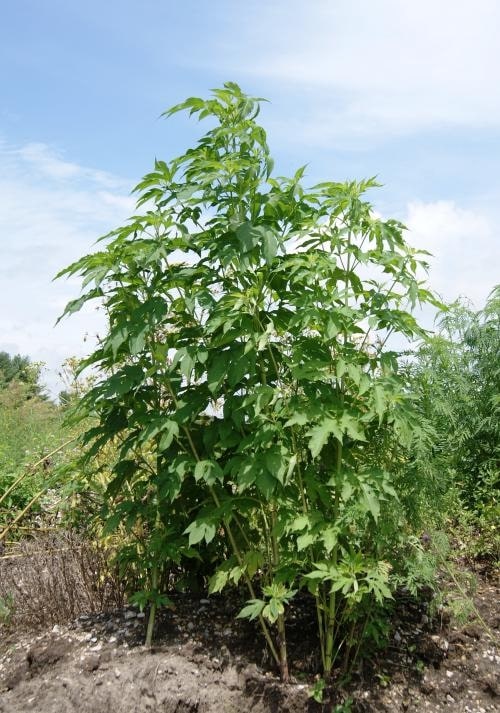
| Scientific Name | Ambrosia trifida |
| Common Name(s) | Giant ragweed |
| Family | Asteraceae |
| Nativity | CanadaNorth AmericaNorthern Mexico |
| Toxicity (Touch) | No |
| Toxicity (Ingestion) | No |
| Unique Characteristics | Oval-lance shaped leaves made up of 3 to 5 lobes with serrated edges |
As its name suggests, the giant ragweed is an enormous weed that grows to be about 12 feet tall with a thick, green stem.
Its oval-lance shaped leaves are also an identifiable characteristic as they’re made up of 3 to 5 lobes with serrated edges and grow to as big as 12 inches long and 8 inches wide.
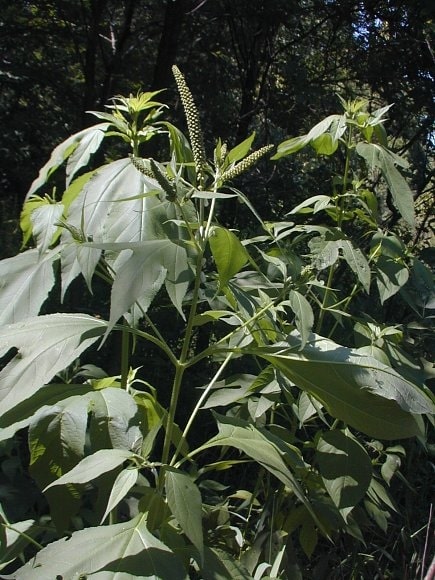
Because of its size, it doesn’t come as a surprise that its presence is quite an environmental threat to nearby plantlife. Aside from that, its pollen is significantly allergenic, hence it’s known to play quite a big role in increasing hay fever cases.
While it’s typically deemed a weed, it does have medicinal uses. In particular, it’s used by herbalists to treat fevers, help with menstrual discomfort, and relieve nausea.
In fact, a few Native American tribes have reportedly used the leaves of the giant ragweed as a laxative. Apart from that, its leaves are also used to soothe irritation from insect bites or rashes.
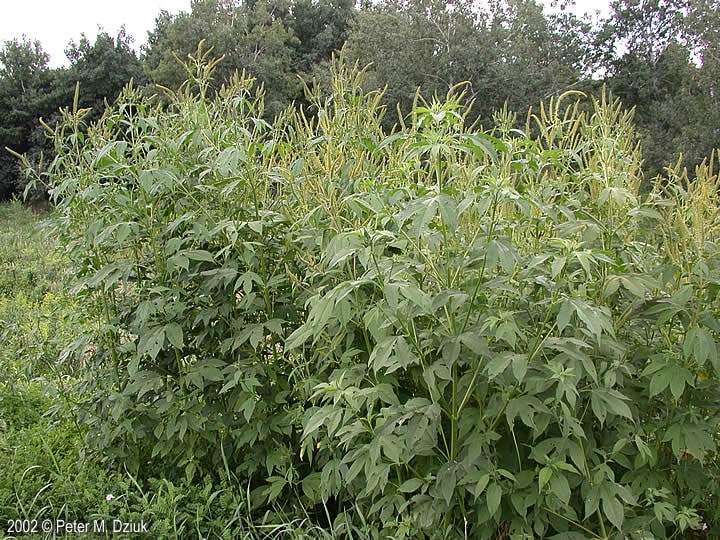
Because of how adaptive the giant ragweed is, it has become able to withstand various strains of herbicides. Nevertheless, here are a few ways that you can deal with them.
How can I get rid of giant ragweed?
#1 Regularly mowing
- Regularly mow the ragweeds down to about 3 to 4 inches from the ground to prevent it from overgrowing.
This will also act as a natural fertilizer, improving your soil’s nutrient content.
#2 Hand pulling the plant
- Cut the stem of the plant about 5 to 10 inches from ground level.
- Loosen the soil by dampening it and prodding at it with a stick or shovel.
- Firmly grip the stem and gently pull upwards. Ensure that the roots do not break off.
- Inspect the ground to check for any root fragments that could have broken off.
#3 Applying a mixture of Mix 2,4-D Amine
- Wear protective gear such as a face mask, goggles, long-sleeved shirt, and pants.
- Measure the square footage of the area that needs to be treated to calculate how much 2,4-D Amine will be needed in the mixture.
| Application Type | Ratio |
| Ornamental turf applications | 2 to 3.16 pints per acre |
| Small applications | .72 to 1.1 fl. oz per 1,000 sq. |
- Shake the sprayer to ensure that all of the components are thoroughly incorporated before evenly coating the foliage.
- Reapplication may be necessary for larger plants
12. Rhododendron
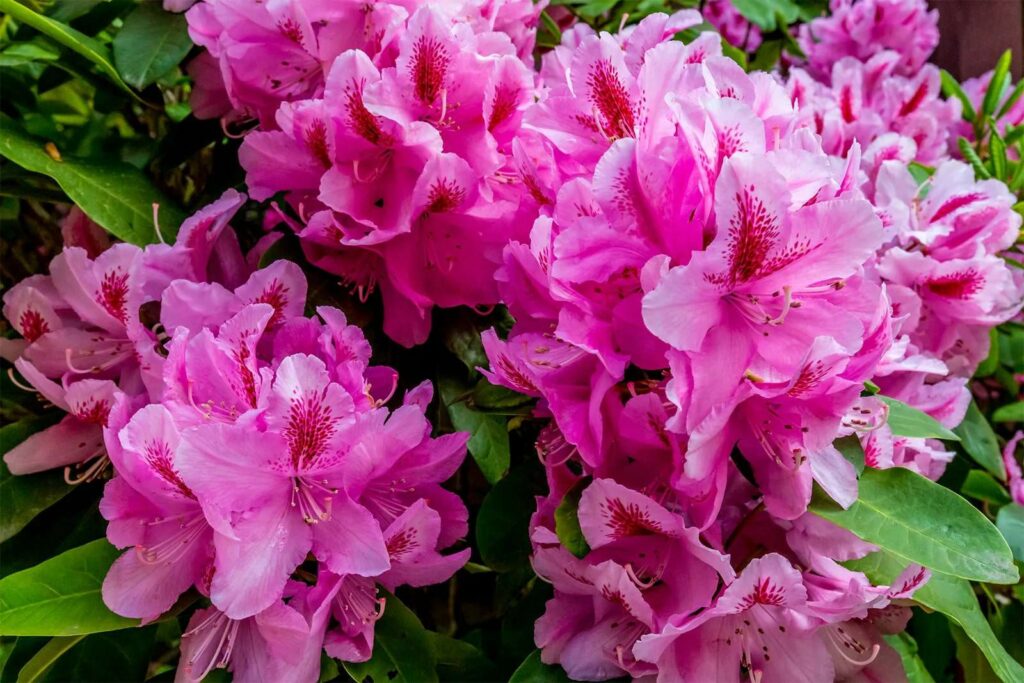
| Scientific Name | Rhododendron ponticum |
| Common Name(s) | RhododendronCommon rhododendronPontic rhododendron |
| Family | Ericaceae |
| Nativity | Iberian peninsulaCaucasus |
| Toxicity (Touch) | No |
| Toxicity (Ingestion) | Yes |
| Unique Characteristics | Tubular, bell, or funnel-shaped flowers that come in white, yellow, pink, orange, purple, and blueDark green and leathery leavesBrown, woody stem |
The rhododendron is well-known for its bushy appearance and bright colored blooms. Hence, it may come as a surprise to some that it’s actually considered a weed in some areas.
Since first introduced in the 18th century as an ornamental plant, the rhododendron has become an invasive weed species in Western Europe and New Zealand.
Nevertheless, they’re still widely considered decorative additions to local parks and communal gardens.
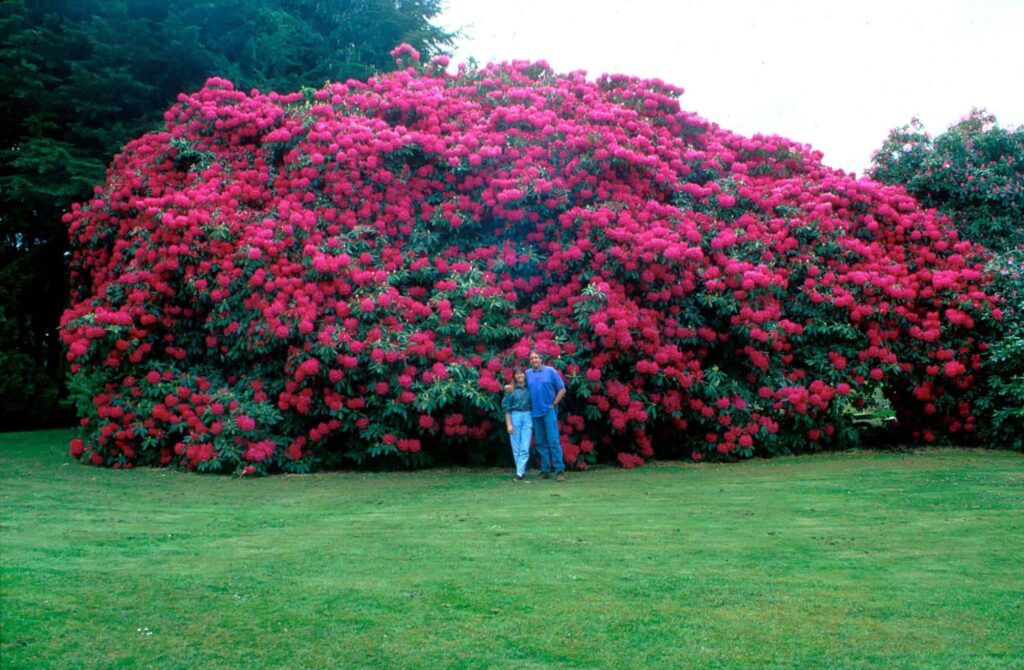
This is primarily attributed to its ability to grow large clusters of tubular, bell, or funnel-shaped flowers. They come in white, yellow, pink, orange, purple, and even blue.
Their leaves, on the other hand, are often dark green and leathery. It has a brown, woody stem which is why it can grow to as tall as 5 meters high and can aggressively spread horizontally.
Hence, they can be quite a pesky weed to deal with when overgrown. Luckily, it has quite a shallow root system, which makes them relatively easy to pull out.
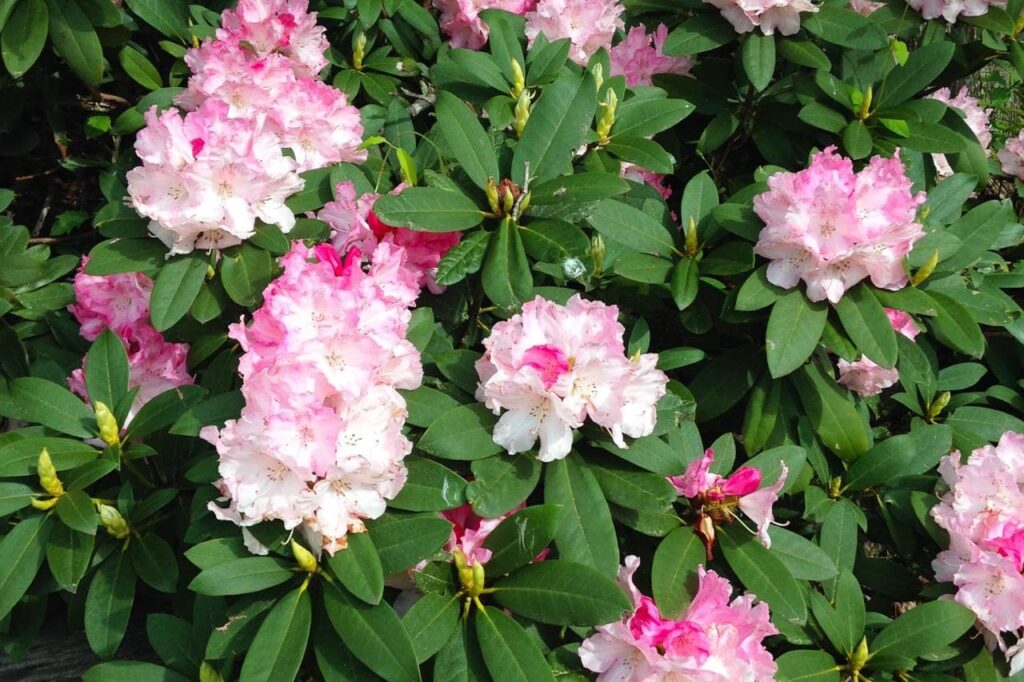
Unbeknownst to some, the pollen and nectar of the rhododendron contains a toxin called “grayanotoxin”.
In fact, honey made from its pollen is also capable of poisoning humans or eliciting allergic reactions. Apart from that, it’s also toxic to cattle, horses, sheep, and goats.
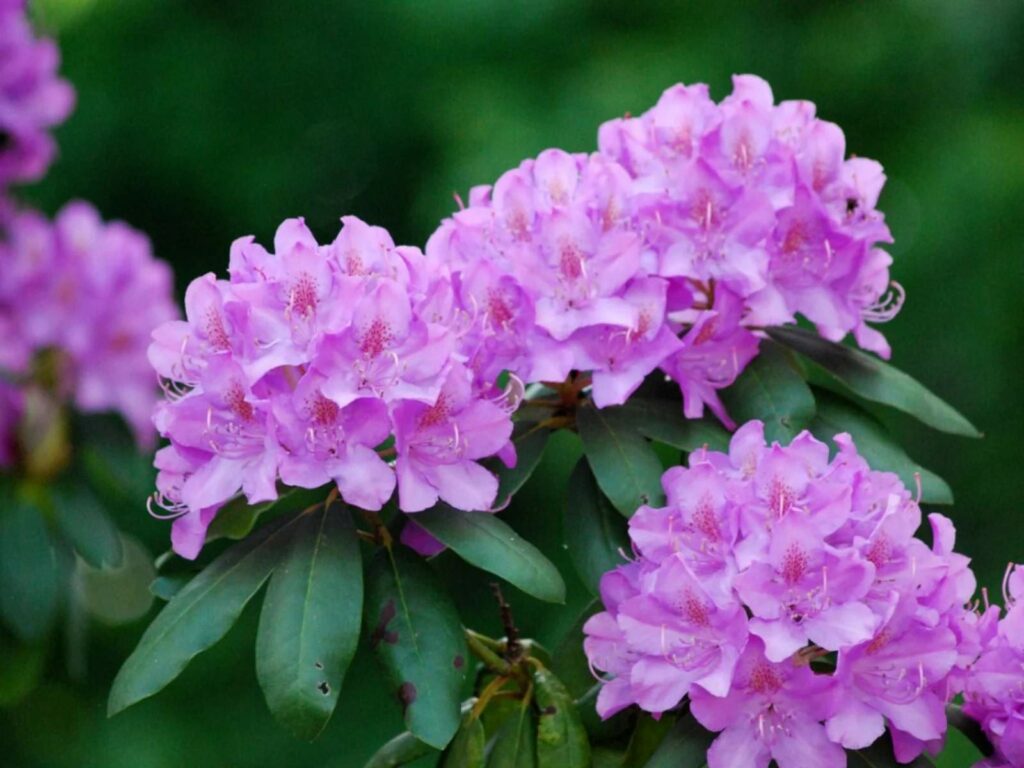
If you’ve got a couple of grazing animals on your property, it’s best to remove any traces of rhododendron on your property to avoid any casualties. Here are a few ways to do that.
How do you stop rhododendrons from growing?
#1 Injecting herbicide directly into the stem
- Measure about 5 to 10 inches off ground level and cut away at the stem.
- Inject herbicide directly into the stump and cover with a plastic sealant.
- Results should be seen within 6 months. If not, cut about an inch off of the stem and inject the herbicide again.
#2 Hand pulling the plant
- Cut the stem down until there’s about 5 to 10 inches left.
- Wet the soil and use a stick to loosen it up.
- Get a firm grip on the stem and carefully yank it out of the ground. If the plant is resisting, wet the soil again and use a spade to loosen the soil.
- After successfully removing the plant, examine the soil for any root fragments.
FAQs on giant weeds
Giant weeds are weeds that grow to atypical sizes, surpassing the typical size of only a couple of feet tall.
They can reach heights of about 10 feet with several species even growing as far as 20 feet long. They tend to grow to abnormal sizes because of the plentiful nutrients freely available in the soil.
Giant weeds aren’t limited to a specific location and can practically be found everywhere, especially in gardens and fields. However, they’ll be more prevalent in areas with an abundance of nutrient-rich soil.
Weeds are invasive plants because they disrupt the natural ecosystems because of how fast they grow, spread, and establish deep root systems.
Weeds typically spread through seeds, spores, and root fragments. They can be carried over to different locations and distances through wind, water, and animals.
Weeds can cause tremendous damage when not managed properly because it can increase the presence of insects, diseases, and bacteria.
Since they’re non-native plants, they cause great damage to crops and native flora as they deplete the land of space, light, water, and nutrients.
The best way to control giant weeds is through chemical herbicides.
While the application method may vary depending on the type of herbicide and size of the weed, chemical herbicides are considered the most affordable, effective, and time-efficient option.




